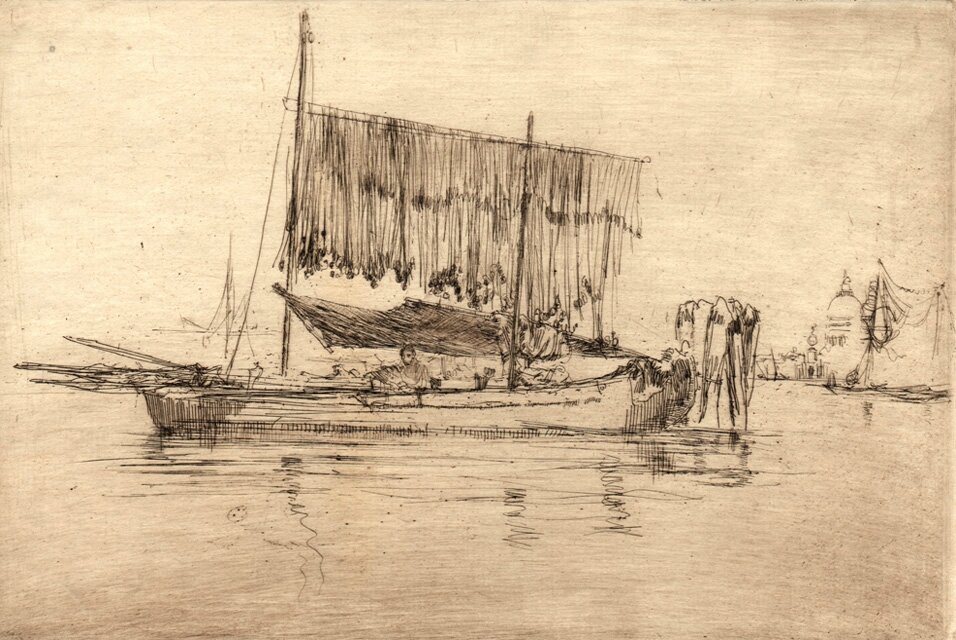An American in Venice: James McNeill Whistler and His Legacy from the Syracuse University Art Collection is an exhibtion on view at the Arkell Museum at Canajoharie, NY, through October 20, 2013.
In 1879 American artist James McNeill Whistler arrived in Italy with a commission from the Fine Arts Society of London to create twelve etchings of Venice. He had already gained international recognition for his paintings Symphony No 1: The White Girl and Arrangement in Grey and Black, No. 1: Portrait of the Artist’s Mother.
During his fourteen months in Venice the artist produced a body of prints that are among the most important of his career. The prints from Whistler’s Venice period are distinguished by the artist’s original approach to capturing the unique qualities of the canaled city and his innovative use of the etching process. His innovations in content, style and technique established a new model for artists of the late-nineteenth and early-twentieth centuries, and this legacy has unmistakably imbued the art of his followers.
Whistler distinguished himself from the landscape artists who had preceded him in Venice by avoiding the city’s tourist sites. He set out to depict a “Venice of the Venetians,” seeking stimulation in the small canals and private courtyards of Venice’s lesser-known quarters. Familiar views and monuments, when they do appear in his art, are often in a hazy distance, seen from an unusual viewpoint, and are printed in reverse due to Whistler’s penchant for drawing his scenes directly on to the copper plate.

James McNeill Whistler, Fishing Boat, 1879-1880, etching on laid paper, Syracuse University
It was during his Venice period, as Whistler confessed to his follower Mortimer Menpes, that he discovered the secret of drawing: “I began first of all by seizing upon the chief point of interest. I would begin drawing that … elaborately, and then would expand from it … If by chance I did not see the whole …, I would not put it in. In this way the picture must necessarily be a perfect thing from start to finish.” The result was a central motif rendered in meticulous detail set within an environment which had been translated on to the plate with a minimum of lines. This left large, open spaces of water and sky which Whistler expertly manipulated in the printing process. Whistler selectively wiped the plate to create atmospheric effects in his surface inking. He also experimented with modern and antique papers and the different effect each created in the final printing.

James Abbott McNeill Whistler Piazzetta, c1879-1880 etching on laid paper 10 x 7 1/8 inches
Whistler’s innovations in this period established him as a master artist and had an acute effect on the art of his followers. While each artist expresses Whistler’s influence in his or her own way, the pervasiveness of Whistler’s impact is aptly described by his closest follower, Mortimer Menpes: "We followers saw things from Whistler's standpoint. If we etched a plate, we had to etch it almost exactly on Whistlerian lines. If Whistler kept his plates fair, ours were so fair that they could scarcely be seen. If Whistler adopted economy of means using the fewest possible lines, we became so nervous that we could scarcely touch the plates lest we should over elaborate."
This exhibit from the Syracuse University Art collection places eleven prints by Whistler from 1879-1880, alongside the work of his followers who were practicing in Italy in the late-nineteenth and early-twentieth centuries. The juxtaposition of these works allows the viewer to appreciate both Whistler’s innovations and the different ways in which his work affected that of the artists who followed him.

John Marin (1870-1953) Palazzo Dario, Venice, 1907, etching on wove paper Syracuse University Collection
The exhibition includes an etching of the Palazzo Dario, Venice by the modern artist John Marin along with works by Mortimer Menpes and Joseph Pennell.
The exhibition also includes remarkable etchings by artists whose reputations have faded over the years.
Whistler’s legacy lies in his far-reaching vision for both his medium and his subject which has made his art significant for a remarkably broad range of colleagues.
From an excellent review (worth reading) in the Times Union (images added):
The brisk repetition of line combined with clouds of ink at the top and bottom of

"Nocturne: Palaces"
suggest mist or rain. With the focus on the shadows at the intersection of two buildings on the canal, line is used economically as sides of buildings fade into the paper. With etching, any place that ink is on the plate results in darkened areas on the print, so the true color of the paper shows through only if the plate is wiped clean. Whistler made unique prints from the same plate by selectively wiping his plates to create atmosphere and contrast.
The show also includes 23 views of Venice by artists who followed Whistler.
Some of these artists depict the landmarks that Whistler avoided.

Minna Bolingbroke's "Venezia"
presents a classic view of a gondola in front of the domed skyline of the city.

Menpes captures the "Bridge of Sighs"
in a dramatic and detailed print that, for all his talk of emulating Whistler, is almost the opposite of Whistler's works in terms of use of line. Menpes consumes every bit of the page.
Whistler's followers didn't always confine themselves to Venice. Three artists approach the same subject in Florence, the Ponte Vecchio, the famed bridge with shops along its span, in different ways. Of the three,

Samuel K. Popkins' vertical take on the bridge best reflects Whistler's influence.

Marjorie Garfield

and Ernest David Roth
each take a more illustrative approach...
This traveling exhibition originated at Syracuse University — all the works are from the University Art Collection.
More images